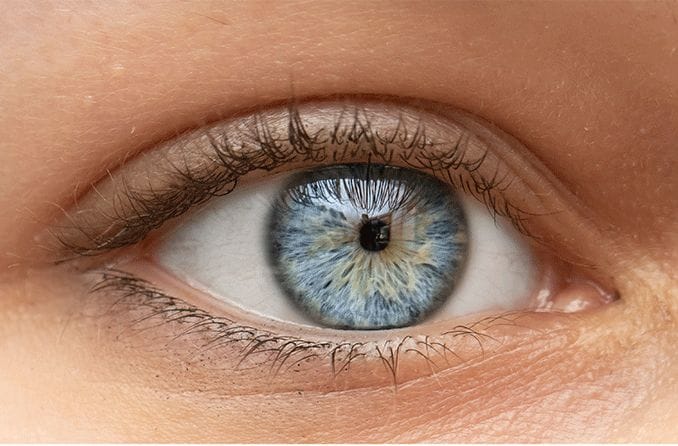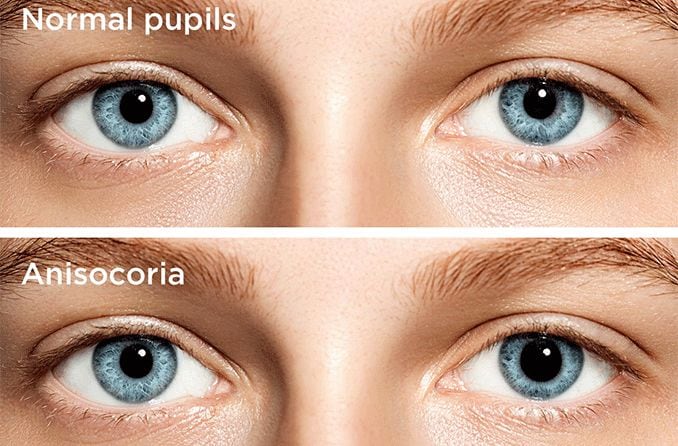What is Marcus Gunn pupil?
Marcus Gunn pupil is a rare condition in which a person’s pupil does not respond to light correctly in one eye. It is also called Marcus Gunn syndrome or relative afferent pupillary defect (RAPD).
In healthy eyes, pupils constrict (get smaller) in bright conditions and dilate (get bigger) in dark conditions. Both pupils constrict together when light is sensed — even if it’s only sensed in one eye. This action is called the consensual light reflex.
People with Marcus Gunn pupil have one eye that activates the consensual light reflex, but the other eye does not. Because patients with a Marcus Gunn pupil do not have unequal pupils, it is not easily noticed. It requires testing by a trained professional such as an ophthalmologist, optometrist or neurologist.
While RAPD on its own is not dangerous, it is often a sign of a serious disorder of the retina, optic nerve or brain. If undiagnosed, these underlying causes may lead to permanent vision damage or even loss of life.
Causes of relative afferent pupillary defect
Relative afferent pupillary defect is usually caused by a problem in the retina (the light-sensitive tissue at the back of the eye) or the optic nerve (the connection that takes the light signal from the eye to the brain). There are also other, less common causes.
Causes related to the retina
Retinal detachment – When a portion of the retina detaches from the back of the eyeball.
Central retinal vein occlusion – When a blood clot blocks blood from leaving the retina.
Central retinal artery occlusion – When a blood clot blocks blood flow into the retina.
Retinal scarring from trauma, infection or inflammation.
Endophthalmitis – Infection and inflammation of the contents of the eye.
Retinal dystrophies such as retinitis pigmentosa – A group of conditions that cause the retina to degenerate progressively over time.
Macular disease or scarring – This can cause an RAPD only when there is extensive damage to this part of the eye (the macula).
Causes related to the optic nerve
Optic neuritis – Inflammation of the optic nerve.
Ischemic optic neuropathy – A problem with the circulation of blood through the optic nerve
Glaucoma – When pressure within the eye becomes too high and begins pressing against the optic nerve.
Optic nerve trauma – When an injury to the eye, the bones surrounding the eye or the head leads to optic nerve damage.
Causes related to the brain
Optic chiasm lesions – Damage to the optic chiasm (where the optic nerves cross paths in the brain) due to abscess, wound or tumor.
Optic tract issues – Damage, injury or inflammation to the optic tract (the part that relays information to the visual cortex of the brain).
Pretectum lesions – Damage to the pretectum (involved in visuomotor behaviors)due to abscess, wound or tumor.
Other causes
Amblyopia – A disorder in eye development resulting in one eye that fails to reach normal visual acuity. Amblyopia, also called lazy eye, usually causes a very small RAPD or none.
Cataracts – Clouding of the eye’s lens. This causes an opposite RAPD. The eye with the cataract will create an increased consensual pupillary response.
Anisocoria – One pupil is a different size than the other. The eye with the smaller pupil will sense less light and display a decreased consensual pupillary response.
SEE RELATED: Polycoria: Causes, symptoms and treatment
Types of relative afferent pupillary defect
There are different levels of severity — or types — of relative afferent pupillary defect. This includes other conditions that are not RAPD, but can cause the symptoms seen in Marcus Gunn syndrome.
Not RAPD – Other conditions such as anisocoria, Adie’s tonic pupil and pupillary hippus give the illusion of RAPD, but it is not actually present.
Mild RAPD – The affected pupil will constrict slightly before dilating.
Moderate RAPD – The affected pupil will not change size at first, then will dilate.
Severe RAPD – The affected pupil immediately dilates in response to light.
Signs of Marcus Gunn syndrome
The main sign of Marcus Gunn syndrome is having one pupil that does not constrict properly in response to light. It is often associated with some form of vision loss, including loss of central vision. Depending on the cause of your RAPD, other symptoms may be present.
For example, if retinal detachment is the cause, you may experience:
Flashes of light in your peripheral vision
Shadows in the periphery of your vision, like curtains closing on a stage
If optic neuritis is the underlying cause, other symptoms may include:
Temporary vision loss in one eye
Eye pain, especially with eye movement
Dyschromatopsia, when one eye sees colors more “bleached out”
Marcus Gunn pupil caused by glaucoma may also cause:
Headaches above one or both eyes
Blurry vision with halos
Nausea and vomiting
It’s possible that other symptoms won’t be very noticeable. It’s important to take notice of changes in your vision and discuss them with your doctor.
SEE RELATED: Tadpole pupil
Diagnosing relative afferent pupillary defect
A widely used method for testing RAPD is called the “swinging light test.” This test uses a narrow-focused light to observe the pupillary light reflex.
The patient will sit in a dimly lit room and focus on a distant object, like the Snellen chart on the wall. While their eyes are focused, the eye doctor will move the light from side to side, shining it directly into each eye.
The doctor will keep the light equally distant from each eye, and hold it for at least three seconds, so the pupil can stabilize. Both pupils will be observed for consensual reflex, though the light is only focused on one eye at a time.
How the pupils respond during this test determines what level of RAPD is present.
Another test that can support the diagnosis of a Marcus Gunn pupil is the “red desaturation test,” in which a patient is asked to look at a red object with one eye at a time. The doctor will ask the patient to rank the object as a brightness of 10 with the unaffected eye, and then will ask what level of brightness (out of 10) the red target appears with the affected eye.
Testing for RAPD when one pupil does not move
There are certain circumstances in which one eye has an unresponsive pupil. These circumstances include trauma, a history of eye surgery, certain medications, third nerve palsy and more. In these circumstances, a “reverse RAPD test” can be done on the functioning pupil.
The same swinging light test is conducted by an eye doctor. But rather than focusing on the non-responsive pupil, like in a typical test, they observe the functioning pupil and how it responds when light is shone in each eye.
When one pupil is unresponsive, anisocoria is usually present as well. Anisocoria can cause a false RAPD and this needs to be taken into account when a reverse RAPD test is performed.
SEE RELATED: Blown pupil
Marcus Gunn pupil treatment
Marcus Gunn pupil cannot be treated directly, as it’s a symptom of an underlying condition. The method of treatment depends on the underlying cause.
Treatment for retinal causes
Retinal detachment treatment involves laser surgery, freezing treatment or other types of surgery.
Retinal vein occlusion can be treated with eye injections of certain medications or laser surgery.
Retinal artery occlusion can often not be treated but the eye needs to be observed to detect glaucoma onset or the growth of new blood vessels in the eye (neovascularization).
Endophthalmitis can be treated with injections of antibiotics and removal of the vitreous jelly from the eye.
Retinal dystrophy can often not be treated but patients may need genetic counseling and information on the expected progression of the disease. A referral for low vision care is frequently needed. Genetic and biomedical treatments are slowly becoming available.
Macula disease can be treated with eye injections of certain medications or other types of surgery. In the case of advanced disease of the macula, there is no treatment.
Treatment for optic nerve causes
Optic neuritis treatment involves intravenous and oral steroids.
Ischemic optic neuropathy is usually treated with oral aspirin therapy to reduce the risk that the other eye develops the same disorder.
Glaucoma can be treated with medicated eye drops, laser treatment and surgery.
Treatment varies for problems in the optic chiasm, optic tract and pretectum. Your eye doctor will be able to recommend the best treatment options for your individual case.
Treatment for other causes
Cataracts can be treated with cataract surgery.
Amblyopia can be corrected by wearing corrective lenses or an eye patch to help strengthen the weaker eye.
Anisocoria may not require treatment. If anisocoria is a sign of an underlying neurological disease, this will need proper diagnosis and treatment.
When to see a doctor
If you notice any unfamiliar changes in the appearance of your eyes, including the size of one or both pupils, it’s best to consult with an eye doctor.
It’s also important to see a doctor if any sudden vision changes occur. This may include sudden blurry vision, an influx of eye floaters, random flashes of light in your vision or other unusual changes.
The sooner you see an eye doctor for your symptoms, the faster they can diagnose and treat the problem and restore your eyesight to normal.
READ MORE: Miosis: What causes constricted pupils?







